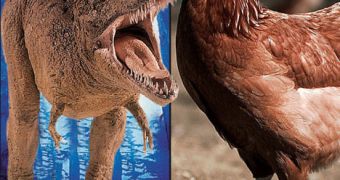T-Rex is by far the most famous of dinosaur species. For 150 years, Tyrannosaurus rex was considered the largest carnivorous species that have ever roamed the earth. And it was, indeed, a huge beast - up to 12.8 (42 ft) in length and 7.2 tonnes in weight. Bigger than an elephant! Meanwhile, in 1993, a longer carnivore dinosaur was found in Argentine: Giganotosaurus measured up to 13.2 m (44 ft) in length, and the largest carnivore dinosaur ever to have existed was proved to be Spinosaurus that inhabited North Africa and whose remains were first discovered in 1910: up to 18 m (59.1 ft) and 9 tonnes heavy.
A new analysis of T-Rex fossilized proteins confirms the beast was more closely related to birds than to crocodilians, living reptiles like the alligator or the crocodile, considered to be closest to dinosaurs. Scientists used a tiny shred of a 68-million-year-old protein coming from the femur bone of a young Tyrannosaurus female and compared it with the similar protein found in 21 modern species of crocodilians and birds.
This fossil collagen is the oldest preserved protein ever found. Collagen is the main compound of animal connective tissue, found in skin, cartilage, ligaments, tendons, hooves, bones and teeth. The T-Rex leg bone was discovered in 2003 in the Hell Creek Formation, a fossil rich area spreading over Montana, Wyoming and North and South Dakota.
The analysis showed that the dinosaur's protein was more similar to that found in birds than that encountered in crocodilians. This establishes a strong connection between dinosaurs and birds, adding to the already existing anatomical proofs, including the existence of feathered dinosaurs.
"These results match predictions made from skeletal anatomy, providing the first molecular evidence for the evolutionary relationships of a non-avian dinosaur," said Dr Chris Organ, an evolutionary biologist at Harvard University, US. Proteins are made of amino acids placed in a sequence encoded in the DNA, thus the protein analysis was somehow like mirroring the DNA of the dinosaurs.

 14 DAY TRIAL //
14 DAY TRIAL //